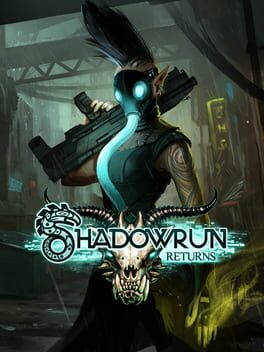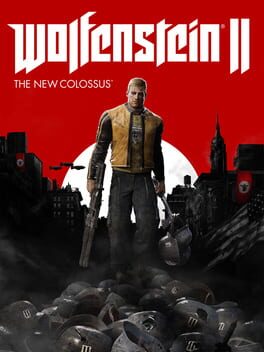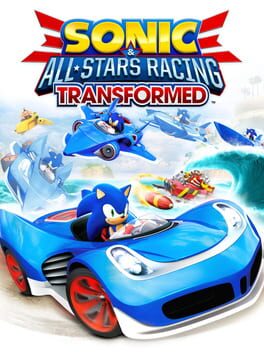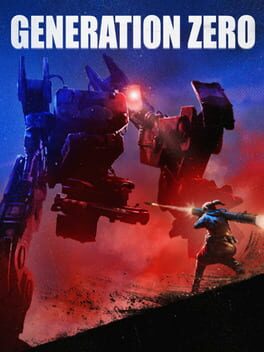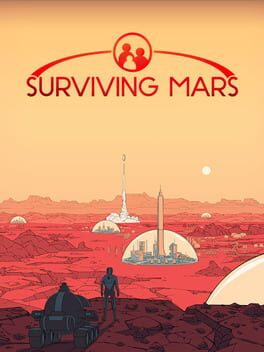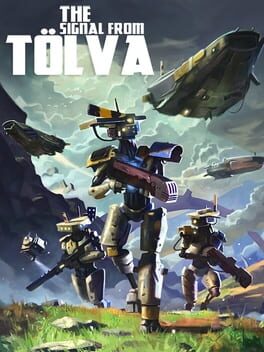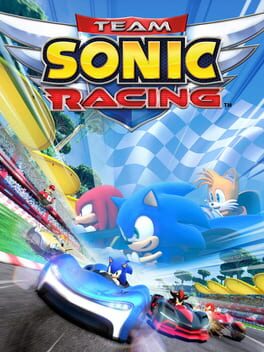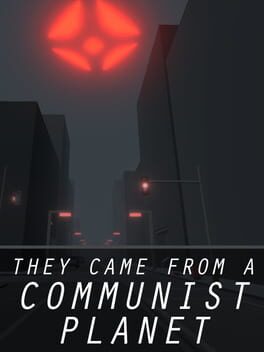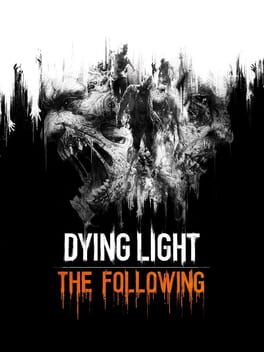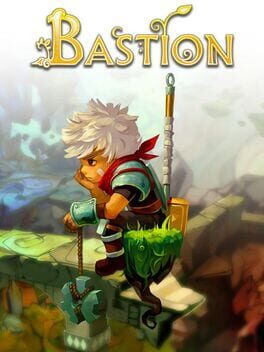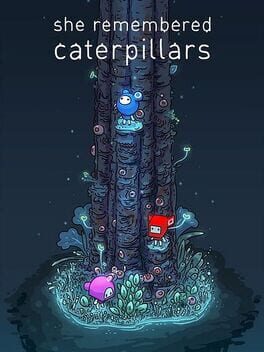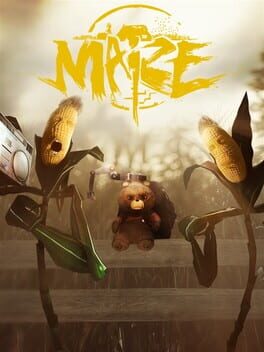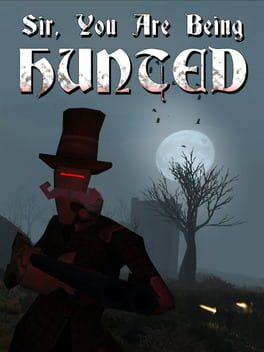astarrgames
2013
I thought this story was going to be a generic murder mystery, but it turned into something else that was very interesting. It seems like the dialogue choices are flavour-text, or grants access to some more items but doesn't change the overall game outcome. That's totally fine for a game that wants to tell this story.
Character creation is based solely around combat, and whatever classes or skills you don't take on, you can fill with teammates and mercenaries. The combat is fine for a turn-based strategy game. It can force you to diversify your team between the cyberdeck, magic, or weapon user, and the random-number game actually makes sense. I've played other TBS games that are frustrating and encourage save-scumming by having an unfair RNG, where everything hits you but you can't hit anything. This one makes sense because you can have supports buff/debuff combatants, take cover, and flank appropriately, while your enemies are trying to do the same.
A couple of pieces of advice on combat to make the game more fun: use items liberally, because you'll always find more. Focus on what you want to fight as and spend money to fill in the gaps you need. I found myself at the end of the game with way too many consumables and cash, while playing conservatively in fights which deprived me of having a lot more fun in this game.
The artwork looks great, between portraits and 3D models. It really sets the mood for a dystopia, and the NPC text really fills out the world to give an accurate picture of the huge world Shadowrun is. The writers really did a lot of work to make you feel like you're within one story in a large universe that has a history and has been lived in - without a prologue or unrealistic text-dump from an NPC.
Character creation is based solely around combat, and whatever classes or skills you don't take on, you can fill with teammates and mercenaries. The combat is fine for a turn-based strategy game. It can force you to diversify your team between the cyberdeck, magic, or weapon user, and the random-number game actually makes sense. I've played other TBS games that are frustrating and encourage save-scumming by having an unfair RNG, where everything hits you but you can't hit anything. This one makes sense because you can have supports buff/debuff combatants, take cover, and flank appropriately, while your enemies are trying to do the same.
A couple of pieces of advice on combat to make the game more fun: use items liberally, because you'll always find more. Focus on what you want to fight as and spend money to fill in the gaps you need. I found myself at the end of the game with way too many consumables and cash, while playing conservatively in fights which deprived me of having a lot more fun in this game.
The artwork looks great, between portraits and 3D models. It really sets the mood for a dystopia, and the NPC text really fills out the world to give an accurate picture of the huge world Shadowrun is. The writers really did a lot of work to make you feel like you're within one story in a large universe that has a history and has been lived in - without a prologue or unrealistic text-dump from an NPC.
2018
I grew up playing the Mechcommander games and was excited for this, until I heard it was turn-based strategy. I tried it out on a free weekend and took it off my wishlist. I ended up getting it with a Humble Bundle and really gave it a shot past the first two missions.
Harebrained Schemes are great at storytelling, considering the Shadowrun series. They took what could have been a generic robot-shooter game and placed you in the middle of the expansive Battletech universe to play through one experience in what could have been thousands. The writing makes you feel like a part of it, and that the characters matter. That is if you choose to dialogue with them, which I highly recommend.
The only TBS I had experience with were X-Com and some RPG games, and the genre usually turns me off because it feels slow, unfair and based on random numbers that are literally hit-or-miss. So, I tried this after a few missions and really began to enjoy the TBS and feel it was an appropriate adaptation of a mech game - especially considering it's derived from a tabletop. As an action game, it feels very good to position and reposition your squad and to take objectives, as much as any isometric action game. The accuracy of your weapons make perfect sense, taking advantage of distances, elevation and structures to retreat, flank, and engage in direct battles, and it really feels fair if you take a chance at shooting a mech in cover and miss. I think back to my Mechcommander days and figure that this is how my missions would play out, except that I have to choose to end turns. It would feel fair that my light took some hits while scouting, and that my heavies could come through the hills to take and receive some as well. This is all because of how you build your mech in the mechlab and which mechwarrior you choose to place in the mech.
The skill trees are well balanced and the mechlab are follows the already well thought out design of a Mechwarrior/Mechcommander game, but a simpler version. There's the usual specifications for mechs between armour, weapons, hardpoints, and equipment, and they made the salvage system feel rewarding and exciting to take parts to the mechlab. The mechwarrior skill trees make sense for balancing the power of firing, taking damage, keeping the mech stable, and calling specific shots on enemies between passive and active skills. There are options to mix and all of these help with building the mech you want and what squads you will send out.
My only complaint is that loads are long, when loading a save, loading a contract then loading the mission. It almost freezes to the point I can't use background apps during the loads, and I'm on a AMD Ryzen 5, with a GTX 1080 and 8GB RAM. I understand that it's developed in Unity, and the landscapes and models really feel like they're constructed with very fine detail. In fact the game looks beautiful for an isometric shooter, and I didn't realize this until I zoomed in, called some orders on my mechs to move and blow up a building, and then watched it crumble to pieces. I'm not sure if the loading feels this bad because the game is actually larger than I thought, or because of optimization. Beyond that, some UI features feel like they're missing, like you can get ready to move a mech, see it's possible positions, line of sight and accuracy of hits, but you can't find the range of a Mech, even after displaying
I'm excited to get through the campaign of this game, go through the expansions and just play, because both the management of a mech squad feels just as great as the strategy and action in missions.
Harebrained Schemes are great at storytelling, considering the Shadowrun series. They took what could have been a generic robot-shooter game and placed you in the middle of the expansive Battletech universe to play through one experience in what could have been thousands. The writing makes you feel like a part of it, and that the characters matter. That is if you choose to dialogue with them, which I highly recommend.
The only TBS I had experience with were X-Com and some RPG games, and the genre usually turns me off because it feels slow, unfair and based on random numbers that are literally hit-or-miss. So, I tried this after a few missions and really began to enjoy the TBS and feel it was an appropriate adaptation of a mech game - especially considering it's derived from a tabletop. As an action game, it feels very good to position and reposition your squad and to take objectives, as much as any isometric action game. The accuracy of your weapons make perfect sense, taking advantage of distances, elevation and structures to retreat, flank, and engage in direct battles, and it really feels fair if you take a chance at shooting a mech in cover and miss. I think back to my Mechcommander days and figure that this is how my missions would play out, except that I have to choose to end turns. It would feel fair that my light took some hits while scouting, and that my heavies could come through the hills to take and receive some as well. This is all because of how you build your mech in the mechlab and which mechwarrior you choose to place in the mech.
The skill trees are well balanced and the mechlab are follows the already well thought out design of a Mechwarrior/Mechcommander game, but a simpler version. There's the usual specifications for mechs between armour, weapons, hardpoints, and equipment, and they made the salvage system feel rewarding and exciting to take parts to the mechlab. The mechwarrior skill trees make sense for balancing the power of firing, taking damage, keeping the mech stable, and calling specific shots on enemies between passive and active skills. There are options to mix and all of these help with building the mech you want and what squads you will send out.
My only complaint is that loads are long, when loading a save, loading a contract then loading the mission. It almost freezes to the point I can't use background apps during the loads, and I'm on a AMD Ryzen 5, with a GTX 1080 and 8GB RAM. I understand that it's developed in Unity, and the landscapes and models really feel like they're constructed with very fine detail. In fact the game looks beautiful for an isometric shooter, and I didn't realize this until I zoomed in, called some orders on my mechs to move and blow up a building, and then watched it crumble to pieces. I'm not sure if the loading feels this bad because the game is actually larger than I thought, or because of optimization. Beyond that, some UI features feel like they're missing, like you can get ready to move a mech, see it's possible positions, line of sight and accuracy of hits, but you can't find the range of a Mech, even after displaying
I'm excited to get through the campaign of this game, go through the expansions and just play, because both the management of a mech squad feels just as great as the strategy and action in missions.
This is really great as both an alternative history story and Nazi killing simulator.
I'm playing this right after Wolfenstein: The New Order and The Old Blood, and it plays like both with some great improvements. The combat can either be stealthy or with guns blazing, while some missions for you to the latter. I really loved Doom 2016 and thought this Bethesda title would be similar for having full speed shootouts. It's not. Stealth is not required but it is heavily weighed to take the game more slowly, watching for soldier patterns and behaviours before engaging. However, the patience always pays off when you're thrust into a high-adrenaline chase or a mission where you're exposed and have to fight your way out.
All combat styles have their rewards with perks and weapon upgrades, which add more flavour to fights and put the balance in your favour. The enemy balance is great, when you're gradually introduced to harder enemies that aren't just base enemies with additional health.
Edit: I originally wrote this complaining about collectables making the game uninteresting or frustrating, because you can find hidden items obscurely placed throughout every map that you revisit twice. It turns out that 1) I'm an achievement hunter which prevents me from having fun in games sometimes, and 2) You can revisit levels at the end of the game. So enjoy your play through and the tid-bits of things you do find laying around maps, then revisit if you want to.
The mission and level design is all very well done and allow for the diverse play styles. There is some repetitiveness when you can revisit some maps for additional, although optional missions. While still optional, this game does suffer from collectables/secrets very obscurely hidden throughout it, which make it tedious for people who want achievements - they don't add perks though which is good.
As for the alternative history aspect, the story continues on from the over-the-top science fiction of The New Order moreso than the horror or the occult of The Old Blood. This game ups the ante by making the sci-fi way more ridiculous and beautifully blends in American action tropes - like having something land on Billy's head every other story beat.
This game is definitely in conversation with our currently political landscape, which is why you have fascist sympathizers outraged over another game villifying Nazis and fans making promo ads splicing in anti-fascists punching out neo-Nazis. To continue with the ridiculous action movie elements Wolfenstein has, the dialogue is very heavy with one-liners and weird tones. There's fantastic exchanges between soldiers if you sneak up on them, when go from discussing their alienated labour, conspiracy theories, and their takes on race and sexuality. There's even a few hilarious interaction between a Nazi soldier and doting southern state American Ku Klux Klan members, which I feel is the highlight of bringing this story to the USA. There's still an emotional depth and grounding of the story, which does change the tone at times from a goofy action game to something that is having an important conversation with white masculinity when Billy's history is explored on the game. Although, my only problem with the tone is how Billy interacts with Black characters as they're finally introduced, as there a major segment of US history Billy has been absent for.
That said, this is such a fun and exciting game. It'll make you laugh, maybe cry, but most importantly, teach you about how Nazis will act when they take over the United States and how to effectively butcher them with hatchets.
I'm playing this right after Wolfenstein: The New Order and The Old Blood, and it plays like both with some great improvements. The combat can either be stealthy or with guns blazing, while some missions for you to the latter. I really loved Doom 2016 and thought this Bethesda title would be similar for having full speed shootouts. It's not. Stealth is not required but it is heavily weighed to take the game more slowly, watching for soldier patterns and behaviours before engaging. However, the patience always pays off when you're thrust into a high-adrenaline chase or a mission where you're exposed and have to fight your way out.
All combat styles have their rewards with perks and weapon upgrades, which add more flavour to fights and put the balance in your favour. The enemy balance is great, when you're gradually introduced to harder enemies that aren't just base enemies with additional health.
Edit: I originally wrote this complaining about collectables making the game uninteresting or frustrating, because you can find hidden items obscurely placed throughout every map that you revisit twice. It turns out that 1) I'm an achievement hunter which prevents me from having fun in games sometimes, and 2) You can revisit levels at the end of the game. So enjoy your play through and the tid-bits of things you do find laying around maps, then revisit if you want to.
The mission and level design is all very well done and allow for the diverse play styles. There is some repetitiveness when you can revisit some maps for additional, although optional missions. While still optional, this game does suffer from collectables/secrets very obscurely hidden throughout it, which make it tedious for people who want achievements - they don't add perks though which is good.
As for the alternative history aspect, the story continues on from the over-the-top science fiction of The New Order moreso than the horror or the occult of The Old Blood. This game ups the ante by making the sci-fi way more ridiculous and beautifully blends in American action tropes - like having something land on Billy's head every other story beat.
This game is definitely in conversation with our currently political landscape, which is why you have fascist sympathizers outraged over another game villifying Nazis and fans making promo ads splicing in anti-fascists punching out neo-Nazis. To continue with the ridiculous action movie elements Wolfenstein has, the dialogue is very heavy with one-liners and weird tones. There's fantastic exchanges between soldiers if you sneak up on them, when go from discussing their alienated labour, conspiracy theories, and their takes on race and sexuality. There's even a few hilarious interaction between a Nazi soldier and doting southern state American Ku Klux Klan members, which I feel is the highlight of bringing this story to the USA. There's still an emotional depth and grounding of the story, which does change the tone at times from a goofy action game to something that is having an important conversation with white masculinity when Billy's history is explored on the game. Although, my only problem with the tone is how Billy interacts with Black characters as they're finally introduced, as there a major segment of US history Billy has been absent for.
That said, this is such a fun and exciting game. It'll make you laugh, maybe cry, but most importantly, teach you about how Nazis will act when they take over the United States and how to effectively butcher them with hatchets.
It's a really good arcade racer!
It's a very forgiving racing game too. I've done a lot of split-screen gaming with someone who doesn't game or even use controllers very much, and compared to other kart games, it wasn't frustrating. Common problems with new players in arcade racers is that it's easy to spin out or take a corner and go the wrong way. There's a few things happening in here that prevent that, and some invisible wall guidance to push people back on track. There's also a very nice assistance for flying. There are a couple of choke points we've had with progression, like the "pursuit" challenges where you have to finish a lap in a certain time.
For someone who's played a lot of arcade racing games and is looking for a fun and challenging experience, this has it too. While the easiest mode is a breeze, the higher challenges improve the AI where they will actually use items properly, drift and use other mechanics to their advantage. It forces the player to learn maps and proper techniques with the cars. There are enough modes to keep the game entertaining and replayable, and it is really easy to invite friends in for local coop or remote play.
Aesthetically, it's a Sega/Sonic 3D game with lots of callbacks, bright colours, and pretty designs. Some sounds and voice lines can be silly, but at least the music has been done in a way where the loops don't feel too repetitive or annoying.
It's great! It's also pretty cheap! If you're looking for an arcade racer to get a few friends together for, this is probably it.
It's a very forgiving racing game too. I've done a lot of split-screen gaming with someone who doesn't game or even use controllers very much, and compared to other kart games, it wasn't frustrating. Common problems with new players in arcade racers is that it's easy to spin out or take a corner and go the wrong way. There's a few things happening in here that prevent that, and some invisible wall guidance to push people back on track. There's also a very nice assistance for flying. There are a couple of choke points we've had with progression, like the "pursuit" challenges where you have to finish a lap in a certain time.
For someone who's played a lot of arcade racing games and is looking for a fun and challenging experience, this has it too. While the easiest mode is a breeze, the higher challenges improve the AI where they will actually use items properly, drift and use other mechanics to their advantage. It forces the player to learn maps and proper techniques with the cars. There are enough modes to keep the game entertaining and replayable, and it is really easy to invite friends in for local coop or remote play.
Aesthetically, it's a Sega/Sonic 3D game with lots of callbacks, bright colours, and pretty designs. Some sounds and voice lines can be silly, but at least the music has been done in a way where the loops don't feel too repetitive or annoying.
It's great! It's also pretty cheap! If you're looking for an arcade racer to get a few friends together for, this is probably it.
2019
I was on the fence with this and leaning towards a positive review. I really enjoyed it and would consider it one of my favourite games, but it took a year in updates and fixes to get there.
I love the idea of cautiously walking through a rural town within a boreal forest in the 1980's while lazer death robots lurk about. The design of the enemies is beautiful and scary, and the survival elements add to the fear of being caught by these machines early on in the game. I've spent a little bit of time in multiplayer to know how good it feels to be in a group of other 80's teens where one of you throws a radio blasting synthpop across from a hiding spot, while another one struggles to hit a softpoint on a robot through a cracked scope on a dilapidated hunting rifle. This game feels like it's just about there and probably would have benefited from being in early access a little bit longer.
The good in this game all comes with some bad. The landscape is gorgeous and frightening, but also pretty empty and boring. The robots are well designed and can be pretty smart hunters, but also stupid things that get caught in walls or running circles. Your equipment is pretty minimal, rustic and it's fair to have cracks and swaying while trying to handle it, but managing these in your inventory is a headache.
A few months later, I finished both DLCs and highly recommend them (Alpine more than FNIX). I feel like a lot of the bugs have been worked out, the cooperative multiplayer is extremely fun (especially the end-game Rival hunting), it's challenge and enjoyable. It's really been the bug fixes that brought me over to highly recommend it, as I already enjoy the setting and combat.
However, I didn't enjoy this in my early-mid game. I found it very unfairly difficult, making me want to avoid encounters all together (it's a FPS, why would I want to avoid shooting things?). Since there's not much onboarding for the combat, I didn't realize that the shooting in this game is very softpoint dependent - meaning that all enemies have weak points that need to be targeted. This can make the difference between spending 10 minutes fighting 15 enemies, using 1000 bullets and 50 med kits - or spending 2 minutes fighting 5 enemies using 100 bullets and 2 meds, making it more fun and engaging that shooting forever at bullet sponges. Take this advice and have fun!
I love the idea of cautiously walking through a rural town within a boreal forest in the 1980's while lazer death robots lurk about. The design of the enemies is beautiful and scary, and the survival elements add to the fear of being caught by these machines early on in the game. I've spent a little bit of time in multiplayer to know how good it feels to be in a group of other 80's teens where one of you throws a radio blasting synthpop across from a hiding spot, while another one struggles to hit a softpoint on a robot through a cracked scope on a dilapidated hunting rifle. This game feels like it's just about there and probably would have benefited from being in early access a little bit longer.
The good in this game all comes with some bad. The landscape is gorgeous and frightening, but also pretty empty and boring. The robots are well designed and can be pretty smart hunters, but also stupid things that get caught in walls or running circles. Your equipment is pretty minimal, rustic and it's fair to have cracks and swaying while trying to handle it, but managing these in your inventory is a headache.
A few months later, I finished both DLCs and highly recommend them (Alpine more than FNIX). I feel like a lot of the bugs have been worked out, the cooperative multiplayer is extremely fun (especially the end-game Rival hunting), it's challenge and enjoyable. It's really been the bug fixes that brought me over to highly recommend it, as I already enjoy the setting and combat.
However, I didn't enjoy this in my early-mid game. I found it very unfairly difficult, making me want to avoid encounters all together (it's a FPS, why would I want to avoid shooting things?). Since there's not much onboarding for the combat, I didn't realize that the shooting in this game is very softpoint dependent - meaning that all enemies have weak points that need to be targeted. This can make the difference between spending 10 minutes fighting 15 enemies, using 1000 bullets and 50 med kits - or spending 2 minutes fighting 5 enemies using 100 bullets and 2 meds, making it more fun and engaging that shooting forever at bullet sponges. Take this advice and have fun!
2018
This review was written in two parts, the first half after my first playthrough, thus the sudden change in tone.
It's great! I grabbed this because it's from teams that do very good city builders - Haemimont Games did Tropico 4 and Paradox publishes a huge list of strategy/building games.
The setting for Mars can be a very bleak and boring landscape, which it kind of is in this game. Everything is kind of a dull, reddish sand texture with some mountains. However, placing your retro-futurist buildings in middle of it does give it a really nice aesthetic, and the skins and radio stations help out a lot with that.
I've played through the tutorial and a couple of new games, and I feel like it's a very easy to learn city builder. You manage about 6 resources, 3 which are early stages and 3 which become factors when you start to put colonists on the planet. 3 additional resources don't actually show themselves - electricity, water, and oxygen - but factor heavily into the city building, especially when working with colonists.
It almost feels like 2 different games are happening here, outside the dome on the planet's surface, and inside the dome managing people. The resources are all balanced nicely, and the systems are pretty forgiving if you're not managing properly, by ordering in supplies from Earth.
It's really fun to begin building on the planet, because there is exploration and minor resource management. The middle game is fun because you need to figure out how to get people on the planet and ensure they survive. Then the late game is fun because you get to expand when the cities are well managed, troubleshoot when problems arise, or challenge yourself with the planetary map and the missions you can participate in.
I find this pretty easy because I've been into strategy and city building games since the 90's, and breezed through a few recent ones this decade including Banished, Northgard and the Tropico series. It does separate itself from earth-based or early-civilization city builders not just because it's on another planet, but because you're challenged by confinement, managing contained cities that don't sprawl as a normal simulated city would and building where you can remotely or electronically control buildings and units. It gets difficult when you don't have the resources from Earth to help out, or when disasters and sabotage throw a wrench in your city planning. It gets creative when you learn new technologies or try to challenge yourself and other sponsored civilizations to meet certain goals.
Overall, I found this properly manageable and well-paced. It'll be a city builder that was easy to get into and I thought I would keep coming back to it...
Then, after two full playthroughs I have more criticisms. While this is a beautiful, interesting, and unique citybuilder, I'm finding more flaws as I complete the game. One main flaw, is that I don't feel like I'm told I've "completed" the game, after succeeding every milestone as the hardest difficulty nation, finishing all of my nation's goals, and 100% terraforming the planet.
This coincides with the pacing being slightly off. The beginning has such an interesting and thrilling pace - you're competing against other nations for milestones and you're trying to get ready for humans to land. Then when they land you have to scramble to make sure they survive, and get ready for more colonists. If you're good at citybuilders, you've beaten the other nations by lightyears and don't have to keep that fast pace. There will be a lull for a while, then a mid-game mystery that forces you to make dramatic decisions on the planet, which is really fun! Then you beat it and look for more milestones, achievements, and 100% finishing the DLC. In over 150 hours, I've passed the tutorial and "won" the game twice, but by the end of both playthroughs, I had the speed cranked, did absolutely no micromanagement, and wasn't paying much attention to anything.
A big problem is the lack of diversity in city building, you only have a few resources to manage and at most two ways to manage them all. The other would be the lack of purpose or missions that force you to do decision making that can alter your play style. The mid-game mission is great, and there are some challenges throughout, but they aren't enough to drastically change what you build or where you've built on the map.
It was great, but I'll probably uninstall this and maybe revisit in 2-3 years, if the new DLC didn't seem to break the game.
It's great! I grabbed this because it's from teams that do very good city builders - Haemimont Games did Tropico 4 and Paradox publishes a huge list of strategy/building games.
The setting for Mars can be a very bleak and boring landscape, which it kind of is in this game. Everything is kind of a dull, reddish sand texture with some mountains. However, placing your retro-futurist buildings in middle of it does give it a really nice aesthetic, and the skins and radio stations help out a lot with that.
I've played through the tutorial and a couple of new games, and I feel like it's a very easy to learn city builder. You manage about 6 resources, 3 which are early stages and 3 which become factors when you start to put colonists on the planet. 3 additional resources don't actually show themselves - electricity, water, and oxygen - but factor heavily into the city building, especially when working with colonists.
It almost feels like 2 different games are happening here, outside the dome on the planet's surface, and inside the dome managing people. The resources are all balanced nicely, and the systems are pretty forgiving if you're not managing properly, by ordering in supplies from Earth.
It's really fun to begin building on the planet, because there is exploration and minor resource management. The middle game is fun because you need to figure out how to get people on the planet and ensure they survive. Then the late game is fun because you get to expand when the cities are well managed, troubleshoot when problems arise, or challenge yourself with the planetary map and the missions you can participate in.
I find this pretty easy because I've been into strategy and city building games since the 90's, and breezed through a few recent ones this decade including Banished, Northgard and the Tropico series. It does separate itself from earth-based or early-civilization city builders not just because it's on another planet, but because you're challenged by confinement, managing contained cities that don't sprawl as a normal simulated city would and building where you can remotely or electronically control buildings and units. It gets difficult when you don't have the resources from Earth to help out, or when disasters and sabotage throw a wrench in your city planning. It gets creative when you learn new technologies or try to challenge yourself and other sponsored civilizations to meet certain goals.
Overall, I found this properly manageable and well-paced. It'll be a city builder that was easy to get into and I thought I would keep coming back to it...
Then, after two full playthroughs I have more criticisms. While this is a beautiful, interesting, and unique citybuilder, I'm finding more flaws as I complete the game. One main flaw, is that I don't feel like I'm told I've "completed" the game, after succeeding every milestone as the hardest difficulty nation, finishing all of my nation's goals, and 100% terraforming the planet.
This coincides with the pacing being slightly off. The beginning has such an interesting and thrilling pace - you're competing against other nations for milestones and you're trying to get ready for humans to land. Then when they land you have to scramble to make sure they survive, and get ready for more colonists. If you're good at citybuilders, you've beaten the other nations by lightyears and don't have to keep that fast pace. There will be a lull for a while, then a mid-game mystery that forces you to make dramatic decisions on the planet, which is really fun! Then you beat it and look for more milestones, achievements, and 100% finishing the DLC. In over 150 hours, I've passed the tutorial and "won" the game twice, but by the end of both playthroughs, I had the speed cranked, did absolutely no micromanagement, and wasn't paying much attention to anything.
A big problem is the lack of diversity in city building, you only have a few resources to manage and at most two ways to manage them all. The other would be the lack of purpose or missions that force you to do decision making that can alter your play style. The mid-game mission is great, and there are some challenges throughout, but they aren't enough to drastically change what you build or where you've built on the map.
It was great, but I'll probably uninstall this and maybe revisit in 2-3 years, if the new DLC didn't seem to break the game.
This game is decent. I enjoyed it but had my problems with it. I read from a couple of people who did the same thing as me, which was trying it out for a couple of hours and then set it aside for months. When I finally got back into it, I actually really appreciate it with some minor criticisms that may completely turn others off of the game. I've played for about 10 hours, but could have been finished a lot earlier if I weren't hunting achievements, and even then felt like I could have been finished with it a little earlier.
The on-boarding for this game isn't that great. After an hour or two of starting the game, I didn't know who I was, what I was doing or why I was doing it. After realizing that there are pretty much three mission types (control point, scan an area, and find the hidden objects), as well as what mechanics you have available (shield, aoe, and scan) it clicked for me and I started to enjoy it.
The Signal From Tölva is very close to being a walking simulator but is definitely a first-person shooter. I really enjoyed Sir, You Are Being Hunted by the same developers, which is a stealth/walking simulator that some aspects carried over into TSFT.
The walking in this game is interesting, much like SYABH, Big Robot LTD does a pretty good job with making an open environment interesting to walk through. They do this well by making menacing structures and landscape in the distance, with interesting stationary pieces with pretty decent graphics and the possibility of some hostiles in the distance to watch for. Walking actually makes me feel like a clunky robot that is glitching out.
The landscape looks very minimal, but not bad. It does feel kind of empty, but in the sense that they purposely created a strange, empty, alien landscape that has a story behind every structure or craft that crashed on the land. The lighting and visuals are very well done, and add to the effect of making you feel like that buggy robot that has scrambled vision, or is shifting its optics to a scan mode. The audio from the ambience, robots and music is very appropriate and pleasant. There's some kinds of "life" on the planet that you hear coming and going, and the robots will chatter with one another similarly to SYABH. The music fits the moods, and that despite being a low-fi, down-temp kind of synth music, it doesn't feel repetitive or abrasive, and it does escalate with the scenario.
Then the negatives. The walking feels tedious, especially if you're not sure where you're going, or you know you'll be travelling through the same terrain to complete an objective or after a respawn. It feels tedious because the land can be difficult to traverse, with clipping problems if you try to climb or squeeze between objects, and big, empty spaces with a few rocks placed in it. Thankfully, there's no jumping puzzle or collectibles/mission items that were in inaccessible areas, because there's always a clear path to follow through the map.
Coming off of SYABH, I'm surprised by the lack of enemy diversity. There's really robot humanoids that have about 3 models, as well as flying drones, stationary turrets and moving turrets that only appear during scripted events. In SYABH, you're introduced to different types of enemies, that gradually increase in difficulty, size, and behaviours. In TSFT, the enemy difficulty increases because the 3 models of robots carry different guns and appear in increased numbers.
The story wasn't too interesting to me, but it did leave off with a decent question. I didn't feel a connection to my robots or faction, and it was probably because the banter I received from anyone else was minimal. Even then, the instructions you receive from your robot boss isn't much, and usually expresses the same information you already know. It would have been great to hear more from robots around you, because the robot banter is great. The codex that tells the story is decent, with some humour thrown in, but I didn't really feel obliged to read each entry. That may be my own personal taste, but I still enjoyed the game regardless of not being invested into the plot.
Finally, the first person action of this game can be great, or mediocre. To start, there are about 5 different types of weapons, including the usual arsenal of a pistol, assault rifles, and sniper rifles. The other two types are a streaming beam weapon and a robot controller, which are both actually pretty neat and add to the styles of shoot-outs you can get into. The action is great when you're trying to take a control point, and suddenly a group of allies pop in to help out, then the enemies get their own backup, and the fire fight escalates dramatically which feels like the FPS it should be. However, I found that I picked my two favourite weapons, and every encountered felt the exact same: snipe the enemies, activate their shields, cover until they get close, jump out to perform an AOE and rifle the rest down. Nothing encouraged me to change this style of fighting, except a brief stint of controlling robots and sending them into fight, but that was not sustainable in certain regions.
Even then, I really enjoyed my time with this game and recommend it. Although, I really recommend watching some gameplay, because this will be 50-50 between the aesthetics of the planet and how a shoot-out will usually go. I do want to say that this game is very well made, and feels like an indie that can really compete against AA or even some AAA titles.
The on-boarding for this game isn't that great. After an hour or two of starting the game, I didn't know who I was, what I was doing or why I was doing it. After realizing that there are pretty much three mission types (control point, scan an area, and find the hidden objects), as well as what mechanics you have available (shield, aoe, and scan) it clicked for me and I started to enjoy it.
The Signal From Tölva is very close to being a walking simulator but is definitely a first-person shooter. I really enjoyed Sir, You Are Being Hunted by the same developers, which is a stealth/walking simulator that some aspects carried over into TSFT.
The walking in this game is interesting, much like SYABH, Big Robot LTD does a pretty good job with making an open environment interesting to walk through. They do this well by making menacing structures and landscape in the distance, with interesting stationary pieces with pretty decent graphics and the possibility of some hostiles in the distance to watch for. Walking actually makes me feel like a clunky robot that is glitching out.
The landscape looks very minimal, but not bad. It does feel kind of empty, but in the sense that they purposely created a strange, empty, alien landscape that has a story behind every structure or craft that crashed on the land. The lighting and visuals are very well done, and add to the effect of making you feel like that buggy robot that has scrambled vision, or is shifting its optics to a scan mode. The audio from the ambience, robots and music is very appropriate and pleasant. There's some kinds of "life" on the planet that you hear coming and going, and the robots will chatter with one another similarly to SYABH. The music fits the moods, and that despite being a low-fi, down-temp kind of synth music, it doesn't feel repetitive or abrasive, and it does escalate with the scenario.
Then the negatives. The walking feels tedious, especially if you're not sure where you're going, or you know you'll be travelling through the same terrain to complete an objective or after a respawn. It feels tedious because the land can be difficult to traverse, with clipping problems if you try to climb or squeeze between objects, and big, empty spaces with a few rocks placed in it. Thankfully, there's no jumping puzzle or collectibles/mission items that were in inaccessible areas, because there's always a clear path to follow through the map.
Coming off of SYABH, I'm surprised by the lack of enemy diversity. There's really robot humanoids that have about 3 models, as well as flying drones, stationary turrets and moving turrets that only appear during scripted events. In SYABH, you're introduced to different types of enemies, that gradually increase in difficulty, size, and behaviours. In TSFT, the enemy difficulty increases because the 3 models of robots carry different guns and appear in increased numbers.
The story wasn't too interesting to me, but it did leave off with a decent question. I didn't feel a connection to my robots or faction, and it was probably because the banter I received from anyone else was minimal. Even then, the instructions you receive from your robot boss isn't much, and usually expresses the same information you already know. It would have been great to hear more from robots around you, because the robot banter is great. The codex that tells the story is decent, with some humour thrown in, but I didn't really feel obliged to read each entry. That may be my own personal taste, but I still enjoyed the game regardless of not being invested into the plot.
Finally, the first person action of this game can be great, or mediocre. To start, there are about 5 different types of weapons, including the usual arsenal of a pistol, assault rifles, and sniper rifles. The other two types are a streaming beam weapon and a robot controller, which are both actually pretty neat and add to the styles of shoot-outs you can get into. The action is great when you're trying to take a control point, and suddenly a group of allies pop in to help out, then the enemies get their own backup, and the fire fight escalates dramatically which feels like the FPS it should be. However, I found that I picked my two favourite weapons, and every encountered felt the exact same: snipe the enemies, activate their shields, cover until they get close, jump out to perform an AOE and rifle the rest down. Nothing encouraged me to change this style of fighting, except a brief stint of controlling robots and sending them into fight, but that was not sustainable in certain regions.
Even then, I really enjoyed my time with this game and recommend it. Although, I really recommend watching some gameplay, because this will be 50-50 between the aesthetics of the planet and how a shoot-out will usually go. I do want to say that this game is very well made, and feels like an indie that can really compete against AA or even some AAA titles.
2019
I'm not a big fan of racing games, but recently picked up a lot of arcade racers including all of the Sonic Racing titles. This is by far my favourite and I would argue best in the series. I've played this strictly in couch co-op, so I can't write to the online play. Although I find this to be a very well made and fun cart racer, it's biggest hurdles are accessibility.
The progression of development from Sonic & Sega All-Stars Racing to Sonic & All-Stars Racing Transformed to this is very noticeable. Comparing it to other character cart racers (Mario, Garfield, Crash, etc.) makes more sense than an arcade racer. This is because customization is minimal, unlockable car mods that impact a few statistics, and the dependency on external parts of the race - what items you receive, how you used them, and what environmental effects are interfering with you and the other racers.
These aren't bad things! The game plays very well, coming out of two racers that were already well designed. That is, the drifting feels nice and the car statistics actual do impact handling, and every track is significantly different and they make sense beyond just theme- or skin-changes. The difficulty with this one seems to be ramped up; even on the easiest mode you're moving fast and other racers are utilizing their items more efficiently. As well, position swapping can be so instantaneous, where someone in first can easily drop to 5th or below because they hit a wall or were hit by the right items, and subsequently, position 12 can seem to boost up to position 5 just from hitting a few boosts or getting the items they need. It's designed so items and the environment can have such a large impact on the race.
You'll figure out what tracks you love and hate easily because of their appearance and environmental effects. This is where accessibility is a huge problem against the other Sonic racers. One common complaint I'm seeing is that is that it's more difficult to see and analyze what is happening on your screen. In some levels, the track appears as a "lighter brown" against a "darker brown" of the off-track hazards, or a "lighter blue" to a "darker blue" and so on. This issue is amplified by the fact that there is so much going on - vehicles have glowing effects, multiple items make different effects, everyone's getting and using items, the environment has so many moving parts, every racer is emoting something, there's a bright yellow line behind your teammates, and there's rings everywhere. At certain points, this game looks like a neon bullet hell but in the racing genre, which hinders the actual racing of this racing game.
I grew up with Sonic, played all of the Genesis games, and watched the cartoons in the 90's. Still, most of these characters are new to me and their banter is annoying. I don't think this would be just because I haven't been following the franchise, but it feels written for a much younger generation, and the story is so elementary and repetitive, I can't even bare to watch a second of the cut scenes. It's confusing how these aspects on the game feel so childish, but the gameplay itself is so difficult and complex.
This is a busy cart racer, moreso than just about everything else in its genre. However, it tends to handle it very well with some settings to help, but not enough to make it accessible to everyone. Watch a few playthroughs, or really dive into it before your refund period expires, because if you have difficulty distinguishing some colours of the track apart - including when rockets, boulders, and fire are shooting around everywhere, then this may not be as fun for you.
The progression of development from Sonic & Sega All-Stars Racing to Sonic & All-Stars Racing Transformed to this is very noticeable. Comparing it to other character cart racers (Mario, Garfield, Crash, etc.) makes more sense than an arcade racer. This is because customization is minimal, unlockable car mods that impact a few statistics, and the dependency on external parts of the race - what items you receive, how you used them, and what environmental effects are interfering with you and the other racers.
These aren't bad things! The game plays very well, coming out of two racers that were already well designed. That is, the drifting feels nice and the car statistics actual do impact handling, and every track is significantly different and they make sense beyond just theme- or skin-changes. The difficulty with this one seems to be ramped up; even on the easiest mode you're moving fast and other racers are utilizing their items more efficiently. As well, position swapping can be so instantaneous, where someone in first can easily drop to 5th or below because they hit a wall or were hit by the right items, and subsequently, position 12 can seem to boost up to position 5 just from hitting a few boosts or getting the items they need. It's designed so items and the environment can have such a large impact on the race.
You'll figure out what tracks you love and hate easily because of their appearance and environmental effects. This is where accessibility is a huge problem against the other Sonic racers. One common complaint I'm seeing is that is that it's more difficult to see and analyze what is happening on your screen. In some levels, the track appears as a "lighter brown" against a "darker brown" of the off-track hazards, or a "lighter blue" to a "darker blue" and so on. This issue is amplified by the fact that there is so much going on - vehicles have glowing effects, multiple items make different effects, everyone's getting and using items, the environment has so many moving parts, every racer is emoting something, there's a bright yellow line behind your teammates, and there's rings everywhere. At certain points, this game looks like a neon bullet hell but in the racing genre, which hinders the actual racing of this racing game.
I grew up with Sonic, played all of the Genesis games, and watched the cartoons in the 90's. Still, most of these characters are new to me and their banter is annoying. I don't think this would be just because I haven't been following the franchise, but it feels written for a much younger generation, and the story is so elementary and repetitive, I can't even bare to watch a second of the cut scenes. It's confusing how these aspects on the game feel so childish, but the gameplay itself is so difficult and complex.
This is a busy cart racer, moreso than just about everything else in its genre. However, it tends to handle it very well with some settings to help, but not enough to make it accessible to everyone. Watch a few playthroughs, or really dive into it before your refund period expires, because if you have difficulty distinguishing some colours of the track apart - including when rockets, boulders, and fire are shooting around everywhere, then this may not be as fun for you.
This is such a good expansion to Dying Light and in some cases I prefer it to the original map and story. If you enjoyed Dying Light, this is an absolute must play through.
The story picks up right where you left off in Dying Light and you enter the farmlands outside of the city. All the quests tie in with progression, which as an achievement hunter, was kind of awkward. I advanced my level beyond the story by doing every side quest and event before the story-line, which meant that I had a higher faction reputation than what the story would suggest. This storyline gives a new mystery and conclusion to a zombie story - but not the zombie story. It's really interesting, and somewhat spoiled if you're following Dying Light 2 news. So dig into this first.
I really love farm maps in any game I play, which means I love this one a lot. I understand how it can be frustrating, because it's a flat open land where you will try to evade some zombie pursuits. I'm in New Game+ and infected will spawn randomly in the distance every 3-5 minutes, making it difficult to walk around and force me to drive. The driving is very nice though, the buggy feels better as it upgrades as well as very vulnerable, which is important in a zombie game.
Some minor gameplay tweaks were added that make sense for this kind of level. No new additions of zombie types, unfortunately, but they change some interactions, which is necessary considering you're driving most of this game.
The Following is really a change of scenery in the most-part. If you liked the base-game, this is essentially more of that with a vehicle and new terrain. Both of those things are awesome.
The story picks up right where you left off in Dying Light and you enter the farmlands outside of the city. All the quests tie in with progression, which as an achievement hunter, was kind of awkward. I advanced my level beyond the story by doing every side quest and event before the story-line, which meant that I had a higher faction reputation than what the story would suggest. This storyline gives a new mystery and conclusion to a zombie story - but not the zombie story. It's really interesting, and somewhat spoiled if you're following Dying Light 2 news. So dig into this first.
I really love farm maps in any game I play, which means I love this one a lot. I understand how it can be frustrating, because it's a flat open land where you will try to evade some zombie pursuits. I'm in New Game+ and infected will spawn randomly in the distance every 3-5 minutes, making it difficult to walk around and force me to drive. The driving is very nice though, the buggy feels better as it upgrades as well as very vulnerable, which is important in a zombie game.
Some minor gameplay tweaks were added that make sense for this kind of level. No new additions of zombie types, unfortunately, but they change some interactions, which is necessary considering you're driving most of this game.
The Following is really a change of scenery in the most-part. If you liked the base-game, this is essentially more of that with a vehicle and new terrain. Both of those things are awesome.
2015
This review contains spoilers
I had this on my wishlist forever since finishing the Dead Island series, and picked it up on the really cheap anniversary sale. It's a big improvement in their zombie games and I'll be replaying this one a lot.
The gameplay is amazing. Zombies and human enemies are a bit diverse in their attacks and behaviours. The missions aren't repetative and there's a lot of replayable ones to pick up with and without other people online. The nightmare mode and New Game + modes really change the game and encourage replayability. I went from one-shotting groups of 8 zombies, to making it a strategic effort to even attempt a swing at a lone one, because of how the harder modes change the gameplay.
The story-line is decent despite being cliché at times, from [spoiler] the "love" story, rogue agent, recurring super villian and corrupt government stuff [/spoiler]. Customization is very limited (except they introduced 3 new bulky dudes to play as), but at least the world around you has interesting, funny and frustrating characters that make you really empathize or hate them.
After playing the end of game of this for hundreds of hours, one thing that does bug me is the sound design. There's a few ambient sounds that mimic local audio triggers, like a door breaking or an infested charging at you. While the end game on New Game + adds almost endless charging zombies, it's good to actually know when and where the attacks are coming from based on cues. This can be kind of confusing and frustrating.
The thing that really gets me excited is the parkour. It'll be impossible to go back to any kind of one-level map design where I can't even jump from rooftop to rooftop. The things that really make me anxious and frightened were the climbing missions, especially when the zombies are capable of escalating from mindless, wandering husks to intensely fast and climbing hunters. I find myself breaking sweats and needing to take breathers while climbing cranes to skyscrapers to antennas.
Get it, because this game is really great.
The gameplay is amazing. Zombies and human enemies are a bit diverse in their attacks and behaviours. The missions aren't repetative and there's a lot of replayable ones to pick up with and without other people online. The nightmare mode and New Game + modes really change the game and encourage replayability. I went from one-shotting groups of 8 zombies, to making it a strategic effort to even attempt a swing at a lone one, because of how the harder modes change the gameplay.
The story-line is decent despite being cliché at times, from [spoiler] the "love" story, rogue agent, recurring super villian and corrupt government stuff [/spoiler]. Customization is very limited (except they introduced 3 new bulky dudes to play as), but at least the world around you has interesting, funny and frustrating characters that make you really empathize or hate them.
After playing the end of game of this for hundreds of hours, one thing that does bug me is the sound design. There's a few ambient sounds that mimic local audio triggers, like a door breaking or an infested charging at you. While the end game on New Game + adds almost endless charging zombies, it's good to actually know when and where the attacks are coming from based on cues. This can be kind of confusing and frustrating.
The thing that really gets me excited is the parkour. It'll be impossible to go back to any kind of one-level map design where I can't even jump from rooftop to rooftop. The things that really make me anxious and frightened were the climbing missions, especially when the zombies are capable of escalating from mindless, wandering husks to intensely fast and climbing hunters. I find myself breaking sweats and needing to take breathers while climbing cranes to skyscrapers to antennas.
Get it, because this game is really great.
2011
I finished this game 9 years after its release when the developers have probably just made 2020's Game of the Year.
It's great, as the reviews indicate. The only negatives I'm seeing is personal preference towards narration and voice overs during gameplay.
As for an action-adventure hack-and-slash, it's fun and unique - mostly because of how the world builds around you. The weapons and enemies vary and change enough that you will be challenged, but can find something that feels really comfortable to upgrade and use. I played on normal, but there's an easy mode to just get through the story and experience it.
After 9 years, the graphics and sound design are still fine. The cartoon-y worlds, platforms and characters were just detailed enough to still look decent enough almost a decade later. Some level and object design may not indicate enough that there's a hazard or safe spot to walk on the decaying landscape you're navigating. Sometimes that's intentional, and it's actually very interesting and exciting. The music is still good and hits the beats of the stories appropriately.
The story I think is what a lot of people come to this and other Supergiant games for. I felt it was just fine, I wasn't too invested in the protagonist, narrator or side characters. However, it was the world that actually impacted me more. Each are well written and the plot comes out of every action you take in the game, as well as neat and interesting mechanics that come out of the plot.
This is a classic and has overwhelmingly positive reviews for a lot of reasons.
It's great, as the reviews indicate. The only negatives I'm seeing is personal preference towards narration and voice overs during gameplay.
As for an action-adventure hack-and-slash, it's fun and unique - mostly because of how the world builds around you. The weapons and enemies vary and change enough that you will be challenged, but can find something that feels really comfortable to upgrade and use. I played on normal, but there's an easy mode to just get through the story and experience it.
After 9 years, the graphics and sound design are still fine. The cartoon-y worlds, platforms and characters were just detailed enough to still look decent enough almost a decade later. Some level and object design may not indicate enough that there's a hazard or safe spot to walk on the decaying landscape you're navigating. Sometimes that's intentional, and it's actually very interesting and exciting. The music is still good and hits the beats of the stories appropriately.
The story I think is what a lot of people come to this and other Supergiant games for. I felt it was just fine, I wasn't too invested in the protagonist, narrator or side characters. However, it was the world that actually impacted me more. Each are well written and the plot comes out of every action you take in the game, as well as neat and interesting mechanics that come out of the plot.
This is a classic and has overwhelmingly positive reviews for a lot of reasons.
2016
This review contains spoilers
I was enjoying Maize, and I wanted to keep enjoying Maize. After 2 hours, I had to give it up.
I went into Maize not knowing what to expect. It almost looked like a horror game, and I was just waiting for something bad to happen. The music is pleasant ambience with some eeriness to it, and the setting is cryptic. Pretty soon, the jokes started to hit, and that's what this game is about. It's a linear adventure in the vein of 90's point-and-click adventure games, where everything you can actually interact with is highlighted, and serves an eventual purpose.
The game itself is a very pretty vehicle for delivering this story and humour, which had been great! For 2 hours. There's great comedy about the meta-game of the genre you're playing in, and there's definitely funny punchlines to putting together puzzles and what the outcome is.
There's a lot of great surrealist humour, even in the situation itself, that is reminiscent of the greats like Monty Python or Kids in the Hall. You're in a weird predicament, doing odd things, with strange material left behind from other humans, and everyone just seems to deal with it.
Humour is of course subjective to anyone who experiences it, and I'd like to explain why the fun suddenly stopped for me beyond bad jokes.
I was having fun with the game, until I felt like I spent way too long in an underground labyrinth of sewer-like walls, or white walls, surrounded by junk. A good joke is that the same type of room was planted into this laboratory, but as a player, it was repetitive and frustrating. I was actually getting motion sickness I don't experience often with first-person perspective. In this case it was because I was running through an environment, swinging around hallways, and disorienting myself trying to remember where my last objective was.
[b]Spoilers.[/b] The second one was the jokes stopped being funny. An hour in, I met [spoiler]the teddy bear and started to read through notes left by the scientist and his venture capitalist business partner.[/spoiler] They were each funny at first, from the situations each of them provided, having a [spoiler]Russian teddy bear follow you around, and the venture capitalist think they're building a theme park out of a scientific experimentation centre.[/spoiler]
This is right when the game pivots to meta-gameplay jokes, funny situations, and absurdist comedy to insult humour. Sure, [spoiler]the lab you're stuck in is so poorly designed and the venture capitalist keeps screwing everything up,[/spoiler] but [i]every single joke[/i] boils down to calling the NPCs you don't see and the player-character "stupid," "idiot," "moron" and whatever else to demean their intelligence. It was funny for the first couple of minutes, but that was the running joke - everyone's a stupid idiot, and that's all I hear.
After a full hour of being called a stupid idiot for the hundredth time in a game designed to make me pick up a unicorn-shaped candle, I gave up. I'll just read the ending, which I'm sure will be a bit of a giggle, but I'm not enduring the boring maze and insult comedy anymore. Like, Triumph the Insult Comic Dog is funny in 2-5 minute segments, but this becomes insufferable after an hour.
That all written, I do believe the team does have talent and wits that given another scenario would work. I look forward to Skully and would check that out!
I went into Maize not knowing what to expect. It almost looked like a horror game, and I was just waiting for something bad to happen. The music is pleasant ambience with some eeriness to it, and the setting is cryptic. Pretty soon, the jokes started to hit, and that's what this game is about. It's a linear adventure in the vein of 90's point-and-click adventure games, where everything you can actually interact with is highlighted, and serves an eventual purpose.
The game itself is a very pretty vehicle for delivering this story and humour, which had been great! For 2 hours. There's great comedy about the meta-game of the genre you're playing in, and there's definitely funny punchlines to putting together puzzles and what the outcome is.
There's a lot of great surrealist humour, even in the situation itself, that is reminiscent of the greats like Monty Python or Kids in the Hall. You're in a weird predicament, doing odd things, with strange material left behind from other humans, and everyone just seems to deal with it.
Humour is of course subjective to anyone who experiences it, and I'd like to explain why the fun suddenly stopped for me beyond bad jokes.
I was having fun with the game, until I felt like I spent way too long in an underground labyrinth of sewer-like walls, or white walls, surrounded by junk. A good joke is that the same type of room was planted into this laboratory, but as a player, it was repetitive and frustrating. I was actually getting motion sickness I don't experience often with first-person perspective. In this case it was because I was running through an environment, swinging around hallways, and disorienting myself trying to remember where my last objective was.
[b]Spoilers.[/b] The second one was the jokes stopped being funny. An hour in, I met [spoiler]the teddy bear and started to read through notes left by the scientist and his venture capitalist business partner.[/spoiler] They were each funny at first, from the situations each of them provided, having a [spoiler]Russian teddy bear follow you around, and the venture capitalist think they're building a theme park out of a scientific experimentation centre.[/spoiler]
This is right when the game pivots to meta-gameplay jokes, funny situations, and absurdist comedy to insult humour. Sure, [spoiler]the lab you're stuck in is so poorly designed and the venture capitalist keeps screwing everything up,[/spoiler] but [i]every single joke[/i] boils down to calling the NPCs you don't see and the player-character "stupid," "idiot," "moron" and whatever else to demean their intelligence. It was funny for the first couple of minutes, but that was the running joke - everyone's a stupid idiot, and that's all I hear.
After a full hour of being called a stupid idiot for the hundredth time in a game designed to make me pick up a unicorn-shaped candle, I gave up. I'll just read the ending, which I'm sure will be a bit of a giggle, but I'm not enduring the boring maze and insult comedy anymore. Like, Triumph the Insult Comic Dog is funny in 2-5 minute segments, but this becomes insufferable after an hour.
That all written, I do believe the team does have talent and wits that given another scenario would work. I look forward to Skully and would check that out!
Sir, You Are Being Hunted made me follow Big Robot Ltd for their other games, and really enjoy their work. This game is great, but it does have it's quirks and bugs. They're not major enough to destroy the mood, except for the occasional falling through the ground just after launch.
There's a certain pace to this open-world stealth game that make it exciting and scary. Comparing it to their other first-person game, The Signal From Tölva, there's also a lot of walking, but both find ways to make it interesting and feel fine. In SYABH, there's so much walking, crouching and waiting, but they made it feel necessary and stimulating. You're measuring distances robots are from you, counting robots in the distance against the amount of bullets you have, watching your vitality drop while you're hiding, and calculating your next move.
The sound design is pretty well done, and there's so much listening in this game - every beep, boop, clank and stomp are felt. You're listening for who's making a noise, how many of them, which direction they are, and if they're coming your way. The ambient music and sound are so appropriate, and I enjoy having that suspense broken by a flock of squawking birds giving away my position or the splashing of robot tentacles coming from the water. The narration and robot banter is also a nice break once in a while as its both charming and humorous.
The character design and how new robots appear as your progress is an excellent escalation. My first encounters with hunters was terrifying, and after I felt like I had a handle of luring, evading, and killing them, they introduce more and challenging robots to deal with. They all fit together in a very interesting way, making nothing feel safe by the end of it all. I personally really enjoy the feeling of terror when I see a large, stalking robot in the distance making noises.
As the maps are randomly generated, there's a decent variation to the biomes they create. One of my few issues with the terrain is not being able to properly identify how concealing a bush will or won't be and climbing up steeper slopes or even rocks has some jankiness to it. I've only tried the multiplayer a couple of times, and both times the other player and me fell through the ground - which I believe had been corrected but I haven't played it since.
Although it's been well over 7 years since this has come out, I just finished it after a few failed runs, and still really enjoy it. It's absolutely possible to go back to, which I find myself doing on and off, but I'm glad to have picked this up.
There's a certain pace to this open-world stealth game that make it exciting and scary. Comparing it to their other first-person game, The Signal From Tölva, there's also a lot of walking, but both find ways to make it interesting and feel fine. In SYABH, there's so much walking, crouching and waiting, but they made it feel necessary and stimulating. You're measuring distances robots are from you, counting robots in the distance against the amount of bullets you have, watching your vitality drop while you're hiding, and calculating your next move.
The sound design is pretty well done, and there's so much listening in this game - every beep, boop, clank and stomp are felt. You're listening for who's making a noise, how many of them, which direction they are, and if they're coming your way. The ambient music and sound are so appropriate, and I enjoy having that suspense broken by a flock of squawking birds giving away my position or the splashing of robot tentacles coming from the water. The narration and robot banter is also a nice break once in a while as its both charming and humorous.
The character design and how new robots appear as your progress is an excellent escalation. My first encounters with hunters was terrifying, and after I felt like I had a handle of luring, evading, and killing them, they introduce more and challenging robots to deal with. They all fit together in a very interesting way, making nothing feel safe by the end of it all. I personally really enjoy the feeling of terror when I see a large, stalking robot in the distance making noises.
As the maps are randomly generated, there's a decent variation to the biomes they create. One of my few issues with the terrain is not being able to properly identify how concealing a bush will or won't be and climbing up steeper slopes or even rocks has some jankiness to it. I've only tried the multiplayer a couple of times, and both times the other player and me fell through the ground - which I believe had been corrected but I haven't played it since.
Although it's been well over 7 years since this has come out, I just finished it after a few failed runs, and still really enjoy it. It's absolutely possible to go back to, which I find myself doing on and off, but I'm glad to have picked this up.
